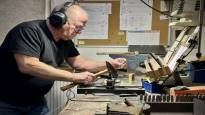BERLIN The door of an ordinary garage in an ordinary suburb opens. A sad-eyed man gently asks for a warm one from the drizzle.
The door slams shut behind it, and no one but the sculptor can open it Michael Friedrichs-Friedländer and his assistant.
The lock must be sturdy in case uninvited guests arrive at the door. The location of the garage is also a secret.
Friedrichs-Friedländer doesn’t take the risk that far-right radicals or anti-Semitic people will find out about his workshop.
It is here in the Friedrichs-Friedländer garage that most of the “stumbling blocks” installed on the streets of European cities and villages are created. They are known to form the world’s largest distributed monument.
Stumbling stones (German: Stolpersteine) are brass plates embedded in the streets to commemorate the Jews, Roma, gays, mentally disabled, Slavs murdered by the Nazis… The Nazis killed a total of more than ten million people, most of whom were Jews.
The father of stumbling blocks is an artist Gunter Demnig. Demnig nailed the first stumbling block to the sidewalk in front of Cologne’s city hall in November 1992, when it was 50 years since the Nazi leader Heinrich Himmler of the order to permanently expel the Roma from Germany.
Demnig’s commemorative plaque gained popularity, and in the following years he expanded his idea into an ongoing project. The motto became “one victim, one stone”. Finally, the orders started pouring in at such a rate that Demnig asked Friedrichs-Friedländer for help in 2005.
– You don’t fall on stumbling blocks, but if you stumble and read the text on the slab, you have to bow down in front of the victim, Demnig has explained in interviews.
In twenty years, Friedrichs-Friedländer has forged and cast almost 89,000 stumbling blocks, which are already on the streets of Europe in 32 countries. The vast majority of all over one hundred thousand installed stumbling blocks originate from his workshop.
– Then only when this becomes routine and I stop caring about the fates of these people, I will stop, 73-year-old Friedrichs-Friedländer says.
For the longest time, he says, he lingers by the memorial plaques of small children. While forging them, you sometimes have to go outside to get some oxygen.
He also doesn’t go straight upstairs to his home at the end of the work day, but does something else in between to clear his head of thoughts.
– When I hit letter by letter, number by number with the hammer, I make sure that these people are not forgotten. These fates always move me.
Friedrichs-Friedländer and his two employees forge more than a hundred stones a week. Now a batch of dozens of stumbling blocks is being prepared for Hamburg.
The engraving on each tile begins with the local language “Täße asui…”. After that comes the name, date of birth and final fate – which is often unknown. For some, the fate was a ride to another country, for others, suicide.
Some of those who received a memorial plaque have even been released from the concentration camp, but the last thing on most of the plaques is: murdered.
One stone costs 120 euros delivered in Germany.
– They are cheap. After the material costs, the hourly wage is low, says Friedrichs-Friedländer.
Gold-colored stones are usually placed in front of homes and houses from which people were forcibly transferred to extermination camps or where they committed suicide while living.
– There are no graves for many who died in concentration camps. That is why stumbling blocks are important places for some relatives.
Stones can be found on the streets from Finland to Sicily and from Norway to Ukraine. There are seven stumbling blocks in Helsinki in memory of the Jews handed over to Nazi Germany.
Stumbling blocks have also caused contradictions. Real estate agents have claimed that they reduce the value of the houses next door.
For example, Munich, known as the birthplace of National Socialism, has decided not to spend public money on the stones initially at the request of a Jewish activist. The reason is that commemorative plaques on the cobblestones would denigrate the dead Jews even more when people walk over these names.
The streets of Munich only have stumbling blocks commissioned by private individuals, while elsewhere they are usually purchased by districts and regions.
